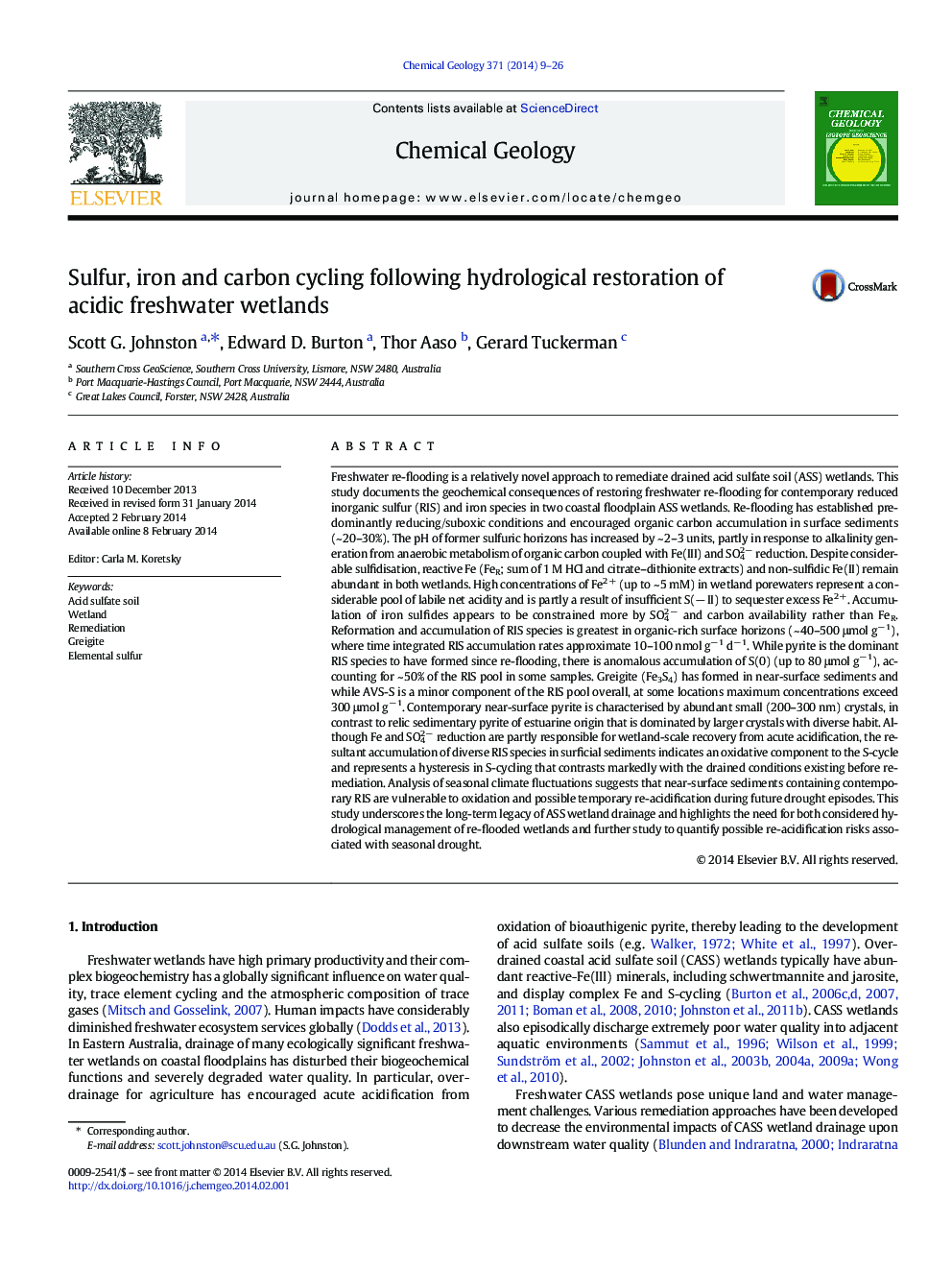| کد مقاله | کد نشریه | سال انتشار | مقاله انگلیسی | نسخه تمام متن |
|---|---|---|---|---|
| 4698756 | 1637599 | 2014 | 18 صفحه PDF | دانلود رایگان |
• We quantify S and Fe species in acid sulfate soil wetlands re-flooded by freshwater.
• Soil and drainage water pH has increased following re-flooding.
• Diverse RIS species (FeS, FeS2, S(0), Fe3S4) have formed near the sediment surface.
• Reactive Fe remains abundant while SO42 − is limiting RIS formation.
• Oxidation of RIS may cause future oscillations in water and sediment acidity.
Freshwater re-flooding is a relatively novel approach to remediate drained acid sulfate soil (ASS) wetlands. This study documents the geochemical consequences of restoring freshwater re-flooding for contemporary reduced inorganic sulfur (RIS) and iron species in two coastal floodplain ASS wetlands. Re-flooding has established predominantly reducing/suboxic conditions and encouraged organic carbon accumulation in surface sediments (~ 20–30%). The pH of former sulfuric horizons has increased by ~ 2–3 units, partly in response to alkalinity generation from anaerobic metabolism of organic carbon coupled with Fe(III) and SO42 − reduction. Despite considerable sulfidisation, reactive Fe (FeR; sum of 1 M HCl and citrate–dithionite extracts) and non-sulfidic Fe(II) remain abundant in both wetlands. High concentrations of Fe2 + (up to ~ 5 mM) in wetland porewaters represent a considerable pool of labile net acidity and is partly a result of insufficient S(− II) to sequester excess Fe2 +. Accumulation of iron sulfides appears to be constrained more by SO42 − and carbon availability rather than FeR. Reformation and accumulation of RIS species is greatest in organic-rich surface horizons (~ 40–500 μmol g− 1), where time integrated RIS accumulation rates approximate 10–100 nmol g− 1 d− 1. While pyrite is the dominant RIS species to have formed since re-flooding, there is anomalous accumulation of S(0) (up to 80 μmol g− 1), accounting for ~ 50% of the RIS pool in some samples. Greigite (Fe3S4) has formed in near-surface sediments and while AVS-S is a minor component of the RIS pool overall, at some locations maximum concentrations exceed 300 μmol g− 1. Contemporary near-surface pyrite is characterised by abundant small (200–300 nm) crystals, in contrast to relic sedimentary pyrite of estuarine origin that is dominated by larger crystals with diverse habit. Although Fe and SO42 − reduction are partly responsible for wetland-scale recovery from acute acidification, the resultant accumulation of diverse RIS species in surficial sediments indicates an oxidative component to the S-cycle and represents a hysteresis in S-cycling that contrasts markedly with the drained conditions existing before remediation. Analysis of seasonal climate fluctuations suggests that near-surface sediments containing contemporary RIS are vulnerable to oxidation and possible temporary re-acidification during future drought episodes. This study underscores the long-term legacy of ASS wetland drainage and highlights the need for both considered hydrological management of re-flooded wetlands and further study to quantify possible re-acidification risks associated with seasonal drought.
Figure optionsDownload as PowerPoint slide
Journal: Chemical Geology - Volume 371, 15 April 2014, Pages 9–26
